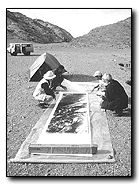![]()
![[ NEWS ]](/images/fall97/newsf97.gif)
![]()
By Greg Clark
Arizona Daily Wildcat October 3, 1997
Clues from the past
![[Picture]](07_1_i.gif)
Photo courtesy John Olsen This stone tool was used by people in Mongolia several thousand years ago. The flint, which flakes easily, was probably used as a block of raw material for making smaller blade-like implements before it became small enough to be used itself as a chopper. |
In the center of Asia's Gobi Desert, some 20 miles from the dusty nomadic
outpost that passed for the nearest town, UA graduate student Jason Rech
spent his summer digging for primitive stone tools and rodent nests in a
Mongolian cave.
His immediate companions in the rocky landscape were two Russian archaeologists and seven Mongolian university students.
Together they spent their days excavating the floor of the cave and their nights in tents living on Russian rations of rice, potatoes, pasta, onions and buckwheat.
"That's all we had," Rech said, "And every three or four days they would butcher a sheep."
"Ketchup becomes very important on an expedition," he said.
Rech and his colleagues were part of the Joint Mongolian-Russian-American Archaeological Expedition that has spent the past three summers exploring sites in Mongolia that may yield clues about early human evolution.

Photo courtesy John Olsen Members of the Joint Mongolian-Russian-American Archaeological Expedition read over a map produced by data from the space shuttle's radar imaging system. Archaeologists used the high-resolution radar images to identify surface and sub-surface features that could yield evidence of prehistoric human occupation in Mongolia. |
Led by University of Arizona archaeologist John Olsen, the American contingent of the expedition consisted of seven members, including UA geography professor Richard Reeves and three UA graduate students.
This summer the expedition continued detailed excavations of two caves, tested two new cave sites and explored previously uninvestigated territory in southern Mongolia near the Chinese border.
The team unearthed thousands of prehistoric stone artifacts, fire pits used by humans more than 8,000 years ago and animal bones which show evidence of being processed by humans.
Collecting archaeological, ecological, geological data, the multidisciplinary team is attempting to piece together an understanding of human prehistoric activity in central Asia.
Larger than the state of Alaska with a population of roughly 2.5 million, Mongolia is sandwiched between Russia and China in the flat desert highlands north of the Himalayas.
Its geographical position in the center of Asia is very important in tracing the path of human evolutionary history, Olsen said.
"Mongolia is right in the middle of where you would expect populations of people to pass as they migrated from one section of the old world to another," he said. "It is a crossroads through which many peoples traversed into and out of East Asia, and they all left evidence of their activity."
"It is a nexus of several cultures," Olsen said. "The Chinese world, the Siberian world and the Near Eastern world all overlap each other there."
Besides its importance as a region that may hold evidence of human activity, Mongolia is important because that evidence is very well preserved, Olsen said.
The geography is filled with limestone caves that early humans used as shelter, he said. Furthermore, Mongolia possesses an abundance of raw material well-suited for making stone tools. The region is also significant because it has been a relatively isolated place during the past few thousand years.
"In the Southwest (United States) we have a lot of archaeological artifacts, but it is heavily populated, so sites have been disturbed by people building houses and roads," Olsen said.
"Right now Mongolia is a very rich archaeological record in a dateable context."
"So little is known about prehistory, virtually everything we find is a piece of the puzzle."
Many of the puzzle pieces are shards of flint and jasper used by stone age humans to make tools, Olsen said. These are smooth stones that flake easily, which allowed early humans to make blades and chopping devices, he added.
Archaeologists can tell a lot about the culture of a people by the technology they used to shape their stone tools, Olsen said.
Jeff Brantingham, a UA graduate student in anthropology who has spent the past three summers in Mongolia working on the joint expedition, said certain types of technology are associated with anatomically modern humans.
Distinguished from earlier evolutionary human stages, the modern human would be one who could show up in any modern city and not be outcast as some kind of freak, Brantingham said.
"Around 40,000 years ago, modern humans began using blades, that is, shards of stone at least two times longer than their width," Brantingham said. "These became the dominant form of tool used by modern humans."
By comparing blades and pieces of raw material used to produce these tools at the Mongolian sites to other tools and materials at other old world sites, the archaeologists hope to determine where and when humans inhabited Mongolia.
"Tools tell us where humans were moving about the landscape," Brantingham said.

Photo by Chris Richards UA anthropologist John Olson holds a wolf's jaw with markings that indicate human tool use, recovered on his most recent trip to Mongolia. Olson said the markings, likely made between 8,000 and 10,000 years ago, indicate sophisticated tool use. |
For example, the stone tools found in one cave were made from a material clearly not from the neighborhood.
"If we can find the source of that material, we can tell how people were moving, perhaps determine migration patterns," Brantingham said.
The expedition unearthed bones of bison, horse, gazelle, and even wolf, all of which had evidence of being butchered by human hands.
Russian members have collected ancient pollens to help determine the makeup of the landscape at earlier historical times.
Rech has been collecting and studying material left by rodents to learn about historical changes in climate and environment.
Rech studies rodent middens, little piles of debris sealed with urine, which were made by picas and voles building nests in the caves, Olsen said.
"Some are so old they are almost solidified," he said.
"Middens are a powerful tool for reconstructing the past environment," Rech said. "We can learn what plants were growing at different times, and plants are directly related to climate, so that can help us understand precipitation and temperature."
Now back in Arizona, Rech plans to analyze the material, consisting of sticks, twigs, seeds and even a small piece of rope. He hopes to date the middens and determine the plant make-up of the material.
"Now there are very few species of small grasses and annuals outside the cave, but inside the cave in various layers of strata there is quite a diversity of species," Rech said.
Overall, Olsen is pleased with the cooperative effort of the tri-national expedition.
The expedition was financed this year by a $50,000 grant from the National Geographic Foundation, Olsen said.
"The Russians provide vehicles, and the Mongolians provide help and furnish 10-12 students who work and are trained by us in methodology and archaeological techniques.
They also provide gasoline at a state-subsidized rate through the Mongolian Academy of Sciences."
"We're all sophisticated enough to realize that the Russians and Mongolians do some things better than us and some things we do better than them, so why not put it all together? It has worked out quite well by emphasizing out teams' strengths," Olsen said.



